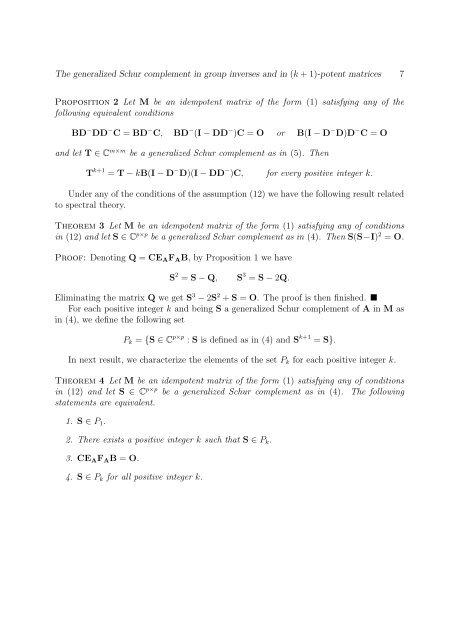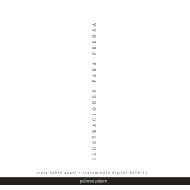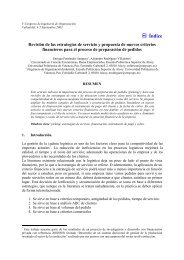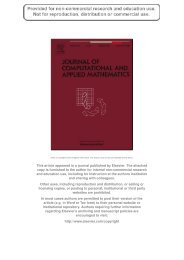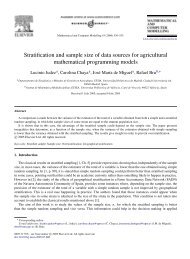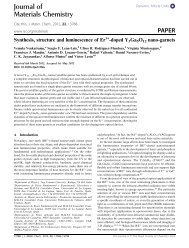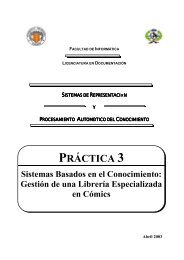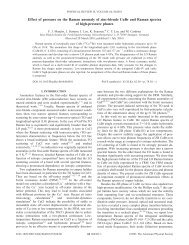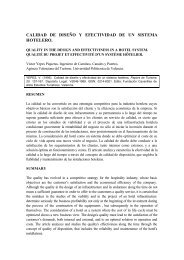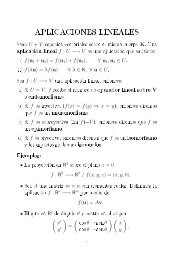The generalized Schur complement in group inverses and (k ... - UPV
The generalized Schur complement in group inverses and (k ... - UPV
The generalized Schur complement in group inverses and (k ... - UPV
You also want an ePaper? Increase the reach of your titles
YUMPU automatically turns print PDFs into web optimized ePapers that Google loves.
<strong>The</strong> <strong>generalized</strong> <strong>Schur</strong> <strong>complement</strong> <strong>in</strong> <strong>group</strong> <strong>in</strong>verses <strong>and</strong> <strong>in</strong> (k + 1)-potent matrices 7Proposition 2 Let M be an idempotent matrix of the form (1) satisfy<strong>in</strong>g any of thefollow<strong>in</strong>g equivalent conditionsBD − DD − C = BD − C, BD − (I − DD − )C = O or B(I − D − D)D − C = O<strong>and</strong> let T ∈ C m×m be a <strong>generalized</strong> <strong>Schur</strong> <strong>complement</strong> as <strong>in</strong> (5). <strong>The</strong>nT k+1 = T − kB(I − D − D)(I − DD − )C, for every positive <strong>in</strong>teger k.Under any of the conditions of the assumption (12) we have the follow<strong>in</strong>g result relatedto spectral theory.<strong>The</strong>orem 3 Let M be an idempotent matrix of the form (1) satisfy<strong>in</strong>g any of conditions<strong>in</strong> (12) <strong>and</strong> let S ∈ C p×p be a <strong>generalized</strong> <strong>Schur</strong> <strong>complement</strong> as <strong>in</strong> (4). <strong>The</strong>n S(S−I) 2 = O.Proof: Denot<strong>in</strong>g Q = CE A F A B, by Proposition 1 we haveS 2 = S − Q, S 3 = S − 2Q.Elim<strong>in</strong>at<strong>in</strong>g the matrix Q we get S 3 − 2S 2 + S = O. <strong>The</strong> proof is then f<strong>in</strong>ished. For each positive <strong>in</strong>teger k <strong>and</strong> be<strong>in</strong>g S a <strong>generalized</strong> <strong>Schur</strong> <strong>complement</strong> of A <strong>in</strong> M as<strong>in</strong> (4), we def<strong>in</strong>e the follow<strong>in</strong>g setP k = {S ∈ C p×p : S is def<strong>in</strong>ed as <strong>in</strong> (4) <strong>and</strong> S k+1 = S}.In next result, we characterize the elements of the set P k for each positive <strong>in</strong>teger k.<strong>The</strong>orem 4 Let M be an idempotent matrix of the form (1) satisfy<strong>in</strong>g any of conditions<strong>in</strong> (12) <strong>and</strong> let S ∈ C p×p be a <strong>generalized</strong> <strong>Schur</strong> <strong>complement</strong> as <strong>in</strong> (4). <strong>The</strong> follow<strong>in</strong>gstatements are equivalent.1. S ∈ P 1 .2. <strong>The</strong>re exists a positive <strong>in</strong>teger k such that S ∈ P k .3. CE A F A B = O.4. S ∈ P k for all positive <strong>in</strong>teger k.


